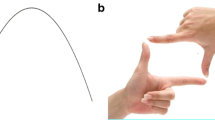Abstract
This research examines how representational gestures (Kita 2000), made by scientists during collaborative discussion in a biochemistry lab, are used in formulating scientific theory. By analyzing digital video of lab meetings and interviews, we find that representational gestures are frequently used to reference, modify, and embody portions of existing material structure such as models, diagrams, and graphs. Representational gestures appear to play a significant role in how scientists both conceptualize and communicate theories. We believe that representational gestures operate as instantiations of essential spatio-dynamic features that are not efficiently conveyed in other modalities, like language and graphical representations, and, as such, are essential resources for sha** theoretical understandings when used in collaborative, face-to-face activity. Gestures may also serve to align cognitive processes in a “community of practice” (Lave 1991) and can package theoretical conjectures into a single semiotic form that can be used symbolically to evoke a rich, shared conceptual history. We use a theoretical framework provided by distributed cognition and embodied cognition to examine jointly shared representational gestures as cognitive artifacts produced and modified by the biochemistry lab community during the practice of theory construction.
Access this chapter
Tax calculation will be finalised at checkout
Purchases are for personal use only
Preview
Unable to display preview. Download preview PDF.
Similar content being viewed by others
References
Banner D (2000) Enzymology: Not just an active site. Nature 404(6777): 449–450.
Becvar LA, Wood MJ, Prieto JH, Melacini G, Komives E (2003) NMR structures reveal how oxidation inactivates thrombomodulin. Biochemistry 42: 11932–11942.
Billinghurst M, Kato H (2002) Collaborative augmented reality. Communications of the ACM 45(7): 64–71.
Cheok A, Weihua W, Yang X, Prince S, Wan F, Billinghurst M, Kato H (2002) Theatre experience in embodied + wearable mixed reality space. In Proceedings of the International Symposium on Mixed and Augmented Reality (ISMAR’02), pp. 317–332.
Clark H (1996) Using Language. Cambridge University Press, New York.
DeRuiter JP (2000) The production of gesture and speech. In McNeill D (ed.) Language and Gesture. Cambridge University Press, New York, pp. 201–226.
Fleck L (1979) Genesis and Development of a Scientific Fact. University of Chicago Press, Chicago.
Francoeur E (2000) Beyond dematerialization and inscription: Does the materiality of molecular models really matter? HYLE: Journal for the Philosophy of Chemistry 2(6): 63–84.
Goldstone RL, Barsalou LW (1998) Reuniting perception and conception. Cognition 65: 231–262.
Goodwin C (1994) Professional vision. American Anthropologist 96(3): 606–633.
Goodwin C (1995) Seeing in depth. Social Studies of Science 25: 237–274.
Goodwin C (2000) Gesture, aphasia, and interaction. In McNeill D (ed.) Language and Gesture. Cambridge University Press, New York, pp. 145–171.
Gullberg M, Holmqvist K (1999) Kee** an eye on gestures: Visual perception of gestures in face-to-face communication. Pragmatics & Cognition 7(1): 35–63.
Halliday R (1987) The construction of objects in scientific discourse. In Halliday R, Martin L (eds.) Writing Science. Cambridge University Press, New York, pp. 191–214.
Heath C, Hindmarsh J (2000) Configuring action in objects: From mutual spaces to media spaces. Mind, Culture and Activity 7: 81–104.
Hutchins E, Palen L (1993) Constructing meaning from space, gesture, and speech. In Resnick LB, Saljo R, Pontecorvo C, Burge B (eds.) Proceedings of NATO Workshop on Discourse, Tools and Reasoning: Situated Cognition and Technologically Supported Environments, pp. 59–79.
Hutchins E (1995) Cognition in the Wild. MIT Press, Cambridge, MA.
Hutchins E (1996) Cognitive artifacts. In MIT Encyclopedia of Cognitive Science. http://cognet.mit.edu/MITECS/Articles/hutchins.html (as of 1/7/07).
Johnson M (1987) The Body in the Mind. University of Chicago Press, Chicago.
Kendon A (1987) Alternate Sign Languages. Oxford University Press, New York.
Kendon A, Muller C (2001) Introducing: GESTURE. Gesture 1(1): 1–7.
Kirsh D (1995) The intelligent use of space. Artificial Intelligence 73(1–2): 31–68.
Kita S (2000) How representational gestures help speaking. In McNeill D (ed.) Language and Gesture. Cambridge University Press, New York, pp. 379–415.
Lakoff G (1987) Women, Fire, and Dangerous Things. Basic Books, New York.
Lakoff G, Nunez R (2000) Where Mathematics Comes From. Basic Books, New York.
Latour B (1979) Laboratory Life. Sage Publications, Inc., Thousand Oaks, CA.
Latour B (1990) Drawing things together. In Lynch M, Woolgar, S (eds.) Representation in Scientific Practice. MIT Press, Cambridge, MA, pp. 45–87.
Lave J (1991) Situating learning in communities of practice. In Resnick L, Levine J, Teasley S (eds.) Perspectives on Socially Shared Cognition. APA, pp. 63–83.
LeBaron C, Streeck J (2000) Gestures, knowledge and the world. In McNeill D (ed,) Language and Gesture. Cambridge University Press, New York.
Levinson S (1983) Pragmatics. Cambridge University Press, New York.
Levy E, Fowler C (2000) Grounding references in perception. In McNeill D (ed,) Language and Gesture. Cambridge University Press, New York, pp. 215–234.
Lidell S (2000) Blended spaces and deixis in sign language discourse. In McNeill D (ed.) Language and Gesture. Cambridge University Press, New York, pp. 266–289.
Lynch M, Woolgar S (1990) Representation in Scientific Practice. MIT Press, Cambridge, MA.
McNeill D (1992) Hand and Mind: What Gestures Reveal About Thought. University of Chicago Press, Chicago.
McNeill D (2000) Catchments and contexts: Non-modular factors in speech and gesture production. In McNeill D (ed.) Language and Gesture. Cambridge University Press, New York, pp. 215–233.
Norman DA (1990) Things That Make Us Smart. Doubleday, New York.
Norman DA, Zhang J, (1994) Representations in distributed cognitive tasks. Cognitive Science 18: 87–122.
Nunez R (1999) Could the future taste purple? Reclaiming mind, body and cognition. Journal of Consciousness Studies 6(11–12): 41–60.
Parrill F (2000) Hand to mouth: Linking spontaneous gesture and aspect. Unpublished BA thesis, University of California, Berkeley.
Pauling L (1951) Personal letter to E.B. Wilson March 7, 1951, Linus Pauling and the Race for DNA: A Documentary History. http://osulibrary.oregonstate.edu/specialcollections/coll/pauling/dna (as of 1/5/07).
Quek F, Kendon A, McCullough K, Duncan S, Ansari R (2001) Catchments, prosody, and discourse. Gesture 1(1): 9–33.
Roth WM (2001) Gestures: Their role in teaching and learning. Review of Educational Research 71: 365–392.
Rumelhart D (1980) Schemata: The building blocks of cognition. In Spiro R, Bruce B, Brewer W (eds.) Theoretical Issues in Reading Comprehension. Lawrence Erlbaum Associate, Hillsdale, NJ, pp. 38–58.
Salomon G (1997) Distributed Cognitions: Psychological and Educational Considerations. Cambridge University Press, New York.
Scheflen A (1976) Human Territories: How We Behave in Spacetime. Prentice-Hall, New York.
Taub S (2001) Language from the Body: Iconicity and Metaphor in American Sign Language. Cambridge University Press, New York.
Varela F, Rosch E, Thompson E (1991) The Embodied Mind: Cognitive Science and Human Experience. MIT Press, Cambridge, MA.
Rights and permissions
Copyright information
© 2008 Springer-Verlag London Limited
About this chapter
Cite this chapter
Becvar, A., Hollan, J., Hutchins, E. (2008). Representational Gestures as Cognitive Artifacts for Develo** Theories in a Scientific Laboratory. In: Resources, Co-Evolution and Artifacts. Computer Supported Cooperative Work. Springer, London. https://doi.org/10.1007/978-1-84628-901-9_5
Download citation
DOI: https://doi.org/10.1007/978-1-84628-901-9_5
Publisher Name: Springer, London
Print ISBN: 978-1-84628-900-2
Online ISBN: 978-1-84628-901-9
eBook Packages: Computer ScienceComputer Science (R0)




